Ah, the thrill of discovery! While for travelers, joy comes in discovering a spectacular scenic view or special restaurant, for bibliophiles, the pleasure arrives while reading a book by a new author, one whose work holds promise for future literary offerings. This week’s column features books by debut children’s and young adult authors who caught our attention.
Ages 4–8
Alma and How She Got Her Name. Juana Martinez-Neal. 2018. Candlewick.
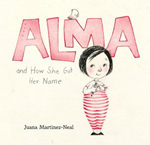 Alma is a small girl with a big name: Alma Sofia Esperanza José Pura Candela. When Alma shows her father how she must tape on an extra strip of paper to fit her name on a printed page, he says, “Let me tell you the story of your name. Then you decide if it fits.” He shows her photos from an album and tells her about each of the relatives for whom she is named. Alma loves the stories, but wants to know about Alma. He replies, “You are the first and the only Alma. You will make your own story.” The illustrations were done as print transfers with graphite and colored pencils. In “A Note from Juana” for her first book as both author and illustrator, Martinez-Neal, who was born in Lima, Peru, and now lives in the U.S., tells about her long name and invites readers to explore the story of their own names.
Alma is a small girl with a big name: Alma Sofia Esperanza José Pura Candela. When Alma shows her father how she must tape on an extra strip of paper to fit her name on a printed page, he says, “Let me tell you the story of your name. Then you decide if it fits.” He shows her photos from an album and tells her about each of the relatives for whom she is named. Alma loves the stories, but wants to know about Alma. He replies, “You are the first and the only Alma. You will make your own story.” The illustrations were done as print transfers with graphite and colored pencils. In “A Note from Juana” for her first book as both author and illustrator, Martinez-Neal, who was born in Lima, Peru, and now lives in the U.S., tells about her long name and invites readers to explore the story of their own names.
—CA
Nimesh the Adventurer. Ranjit Singh. Ill. Mehrdokht Amini. 2018. Lantana.
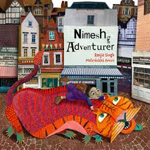 Bright, whimsical, collage-style illustrations provide a glimpse into one young boy's vivid imagination. Nimesh turns the mundane experience of walking home at the end of the school day into a series of adventures as he encounters a dragon, swims with a shark, survives an avalanche, and meets a princess in the park. Each scene and revelation is more and more outlandish, and by the time Nimesh reaches home, readers will be ready for just about anything except what happens. This picture book encourages readers to speculate about what Nimesh will do next and to see the storytelling possibilities in the world around them while appreciating Nimesh's imagination and seriousness as he addresses his unnamed companion (who just might be the reader).
Bright, whimsical, collage-style illustrations provide a glimpse into one young boy's vivid imagination. Nimesh turns the mundane experience of walking home at the end of the school day into a series of adventures as he encounters a dragon, swims with a shark, survives an avalanche, and meets a princess in the park. Each scene and revelation is more and more outlandish, and by the time Nimesh reaches home, readers will be ready for just about anything except what happens. This picture book encourages readers to speculate about what Nimesh will do next and to see the storytelling possibilities in the world around them while appreciating Nimesh's imagination and seriousness as he addresses his unnamed companion (who just might be the reader).
—BW
A Storytelling of Ravens. Kyle Lukoff. Ill. Natalie Nelson. 2018. Groundwood/House of Anansi.
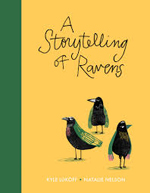 The pairing of Kyle Lukoff’s witty wordplay and Natalie Nelson’s colorful, imaginatively detailed illustrations (made with gouache paint, ink drawings, found photographs, and digital collage) offers a playful exploration of collective nouns used to reference groups of animals: a nuisance of cats, a memory of elephants, a smack of jellyfish, a shrewdness of apes, and 10 more. For example, a double-page spread showing five giraffes nibbling on a tall Christmas tree humorously and sensibly (based upon the giraffe’s feeding habits) illustrates, “The tower of giraffes didn’t know where this new tree had come from, but it was delicious.”
The pairing of Kyle Lukoff’s witty wordplay and Natalie Nelson’s colorful, imaginatively detailed illustrations (made with gouache paint, ink drawings, found photographs, and digital collage) offers a playful exploration of collective nouns used to reference groups of animals: a nuisance of cats, a memory of elephants, a smack of jellyfish, a shrewdness of apes, and 10 more. For example, a double-page spread showing five giraffes nibbling on a tall Christmas tree humorously and sensibly (based upon the giraffe’s feeding habits) illustrates, “The tower of giraffes didn’t know where this new tree had come from, but it was delicious.”
—CA
Ages 9–11
The Outlaw. Nancy Vo. 2018. Groundwood/House of Anansi.
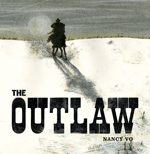 Author–illustrator Nancy Vo uses text sparingly but effectively, employing illustrations to fill the blanks in this powerful story set in the Old West. Residents of a small town dread visits from “the Outlaw,” known for his “trail of misdeeds,” and are relieved when he disappears. After a long absence, a stranger rides into the derelict town and begins to fix things in need of repair. Eventually, as he quietly goes about his tasks, some townsfolk recognize him and become angry as they recall his past transgressions. The Outlaw says nothing, but a small boy steps up and declares, “Leave him alone! He’s trying.” The book's concluding lines—"So the Outlaw continued to make amends. And maybe that was what mattered in the end"—prompt reflection about human nature and forgiveness. Vo’s illustrations, created in ink, watercolor, and newsprint transfer of newspaper clippings and fabric patterns typical of the 1850s and 1860s, effectively set the scene for this thought-provoking tale.
Author–illustrator Nancy Vo uses text sparingly but effectively, employing illustrations to fill the blanks in this powerful story set in the Old West. Residents of a small town dread visits from “the Outlaw,” known for his “trail of misdeeds,” and are relieved when he disappears. After a long absence, a stranger rides into the derelict town and begins to fix things in need of repair. Eventually, as he quietly goes about his tasks, some townsfolk recognize him and become angry as they recall his past transgressions. The Outlaw says nothing, but a small boy steps up and declares, “Leave him alone! He’s trying.” The book's concluding lines—"So the Outlaw continued to make amends. And maybe that was what mattered in the end"—prompt reflection about human nature and forgiveness. Vo’s illustrations, created in ink, watercolor, and newsprint transfer of newspaper clippings and fabric patterns typical of the 1850s and 1860s, effectively set the scene for this thought-provoking tale.
—BW
Winterhouse. Ben Guterson. Ill. Chloe Bristol. 2018. Christy Ottaviano/Henry Holt.
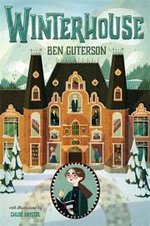 When her uncaring aunt and uncle with whom she lives send 11-year-old orphan Elizabeth Somers on a bus to spend the holidays at Winterhouse, she has an unexpected adventure at the old, luxurious hotel. In its mammoth library, book-loving Elizabeth finds A Guide for Children, a magical book that includes a chapter on an alphabet grid, Vigenère Square, for encoding messages. With the help of Freddy Knox, a boy who shares her love of puzzles, she tries to discover the keyword that will unravel a coded message, written on pages of the book pictured in a portrait of the hotel’s founder, Nestor Falls. Elizabeth is convinced that doing so will clear up the mystery of strange events occurring at Winterhouse and her odd feelings that she has a special connection with the hotel. Readers who like a bit of magic in stories of adventure and mystery can look forward to the sequel, The Secrets of Winterhouse, expected to publish in December 2018.
When her uncaring aunt and uncle with whom she lives send 11-year-old orphan Elizabeth Somers on a bus to spend the holidays at Winterhouse, she has an unexpected adventure at the old, luxurious hotel. In its mammoth library, book-loving Elizabeth finds A Guide for Children, a magical book that includes a chapter on an alphabet grid, Vigenère Square, for encoding messages. With the help of Freddy Knox, a boy who shares her love of puzzles, she tries to discover the keyword that will unravel a coded message, written on pages of the book pictured in a portrait of the hotel’s founder, Nestor Falls. Elizabeth is convinced that doing so will clear up the mystery of strange events occurring at Winterhouse and her odd feelings that she has a special connection with the hotel. Readers who like a bit of magic in stories of adventure and mystery can look forward to the sequel, The Secrets of Winterhouse, expected to publish in December 2018.
—CA
Ages 12–14
The Legends of the Lost Causes (Legends of the Lost Causes #1). Brad McLelland & Louis Sylvester. 2018. Henry Holt.
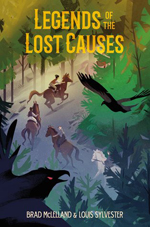 It’s 1855 and 13-year-old Keech Blackwood is living with a family of orphans, Pa Abner, and Granny Nell at Carson’s Home for Lost Causes in the northwestern Missouri hills when a stranger, Bad Whiskey Nelson, comes looking for Pa Abner. When Pa Abner refuses to reveal the location of the powerful Char Stone he is seeking, Bad Whiskey has his zombie outlaws kill him and burn the orphanage. As Keech, the only survivor, sets out to find the Char Stone before Bad Whiskey does, he meets up with other orphans. Upon learning that they share a mysterious bond related to the Char Stone, they band together, intent on avenging the deaths of their families. What follows in an action-packed journey, fraught with dangers and epic battles against the zombies. Readers can expect more thrills and suspense as the group of five orphans, which has adopted the name “The Lost Causes,” continues their adventures in The Fang of Bonfire Crossing (expected to publish in February 2019).
It’s 1855 and 13-year-old Keech Blackwood is living with a family of orphans, Pa Abner, and Granny Nell at Carson’s Home for Lost Causes in the northwestern Missouri hills when a stranger, Bad Whiskey Nelson, comes looking for Pa Abner. When Pa Abner refuses to reveal the location of the powerful Char Stone he is seeking, Bad Whiskey has his zombie outlaws kill him and burn the orphanage. As Keech, the only survivor, sets out to find the Char Stone before Bad Whiskey does, he meets up with other orphans. Upon learning that they share a mysterious bond related to the Char Stone, they band together, intent on avenging the deaths of their families. What follows in an action-packed journey, fraught with dangers and epic battles against the zombies. Readers can expect more thrills and suspense as the group of five orphans, which has adopted the name “The Lost Causes,” continues their adventures in The Fang of Bonfire Crossing (expected to publish in February 2019).
—CA
The Science of Breakable Things. Tae Keller. 2018. Random House.
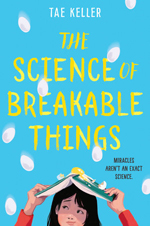 Worried about her mother, who has slipped into deep depression, seventh grader Natalie hatches a desperate plan to rekindle her mother’s interest in life by returning to the place in New Mexico where she first saw the Cobalt Blue Orchids—flowers that defy odds to survive in a toxic environment. A botanist, her mother has built her research around this species, and Natalie is sure that the rare plant holds the key to restoring her health. When she is partnered with her best friend Twig and science geek Dari for a science class project, Natalie is hopeful that their design for an egg drop contest might win the $500 prize, money that could fund the trip to New Mexico. Keller effectively weaves in the application of the scientific method to solve problems and the importance of therapy, exploring territory not typically addressed in books for young readers: parental depression. This book pulls no punches about the challenges of depression and how it affects family members.
Worried about her mother, who has slipped into deep depression, seventh grader Natalie hatches a desperate plan to rekindle her mother’s interest in life by returning to the place in New Mexico where she first saw the Cobalt Blue Orchids—flowers that defy odds to survive in a toxic environment. A botanist, her mother has built her research around this species, and Natalie is sure that the rare plant holds the key to restoring her health. When she is partnered with her best friend Twig and science geek Dari for a science class project, Natalie is hopeful that their design for an egg drop contest might win the $500 prize, money that could fund the trip to New Mexico. Keller effectively weaves in the application of the scientific method to solve problems and the importance of therapy, exploring territory not typically addressed in books for young readers: parental depression. This book pulls no punches about the challenges of depression and how it affects family members.
—BW
Ages 15+
The Beloved Wild. Melissa Ostrom. 2018. Feiwel and Friends.
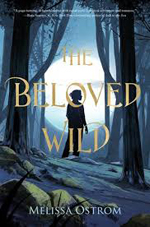 Disillusioned with the path that lies ahead of her in New Hampshire in 1807, 16-year-old Harriet Winter sets out for uncharted territory. She is tired of the role thrust upon her as a female and is disinterested in being married off to a farmer. All she can see ahead of her is a series of pregnancies or death in childbirth. Her brother Gideon hopes to prove himself in the wilderness as he makes plans to stake a claim on several acres in New York’s Genesee Valley. After offending her family and would-be suitor, Harriet accompanies Gideon, cuts her hair, and lives like a boy. Although she relishes the freedom, the work is hard, and eventually she comes to terms with what she wants and realizes that she may have thrown away what she values most. This is a well-written, captivating piece of historical fiction with a flawed protagonist who often behaves rashly but will earn the respect of readers.
Disillusioned with the path that lies ahead of her in New Hampshire in 1807, 16-year-old Harriet Winter sets out for uncharted territory. She is tired of the role thrust upon her as a female and is disinterested in being married off to a farmer. All she can see ahead of her is a series of pregnancies or death in childbirth. Her brother Gideon hopes to prove himself in the wilderness as he makes plans to stake a claim on several acres in New York’s Genesee Valley. After offending her family and would-be suitor, Harriet accompanies Gideon, cuts her hair, and lives like a boy. Although she relishes the freedom, the work is hard, and eventually she comes to terms with what she wants and realizes that she may have thrown away what she values most. This is a well-written, captivating piece of historical fiction with a flawed protagonist who often behaves rashly but will earn the respect of readers.
—BW
A Girl Like That. Tanaz Bhathena. 2018. Farrar, Straus and Giroux.
 Sixteen-year-old Zarin Wadia, a part Hindu, part Parsi orphan lives with her uncle and aunt in Jeddah, Saudi Arabia. Outspoken, smart, and brave, Zarin, who smokes and dates boys, is known as “a girl like that,” the kind with whom no one respectable wishes to associate. Much of the judgments of Zarin come from her own family and her classmates and not the oppressive ruling class or religious police. This complex story, which begins with the death of Zarin and her 18-year-old friend Porus Dumasia in a car accident, is told partly from their post-death points of view and partly by other characters. Readers come to understand that there is much more to both adolescents and to ponder the “what ifs” of their lives. There are many passages that are hard to read, but others remind readers of the healing power of love, whether it be the affection lavished on a pet cat or the unflagging love of a boy for a girl who never regards him as a serious romantic interest. This book is sure to spark rich discussion and controversy about the many issues it raises. Ultimately, it is clear that what everyone seems to think they know about Zarin is nowhere near the whole truth.
Sixteen-year-old Zarin Wadia, a part Hindu, part Parsi orphan lives with her uncle and aunt in Jeddah, Saudi Arabia. Outspoken, smart, and brave, Zarin, who smokes and dates boys, is known as “a girl like that,” the kind with whom no one respectable wishes to associate. Much of the judgments of Zarin come from her own family and her classmates and not the oppressive ruling class or religious police. This complex story, which begins with the death of Zarin and her 18-year-old friend Porus Dumasia in a car accident, is told partly from their post-death points of view and partly by other characters. Readers come to understand that there is much more to both adolescents and to ponder the “what ifs” of their lives. There are many passages that are hard to read, but others remind readers of the healing power of love, whether it be the affection lavished on a pet cat or the unflagging love of a boy for a girl who never regards him as a serious romantic interest. This book is sure to spark rich discussion and controversy about the many issues it raises. Ultimately, it is clear that what everyone seems to think they know about Zarin is nowhere near the whole truth.
—BW
Barbara A. Ward teaches graduate and undergraduate courses in literacy at Washington State University, Pullman. She spent 25 years teaching in the public schools of New Orleans, where she worked with students at every grade level, from kindergarten through high school as well as several ability levels. She is certified in elementary education, English education, and gifted education. She holds a bachelor's degree in communications and a master's degree in English education from the University of Tennessee and a PhD in Curriculum and Instruction from the University of New Orleans. Carolyn Angus is former director of the George G. Stone Center for Children's Books, Claremont Graduate University, in Claremont, California.
These reviews are submitted by members of the International Literacy Association's Children's Literature and Reading Special Interest Group (CL/R SIG) and are published weekly on Literacy Daily.